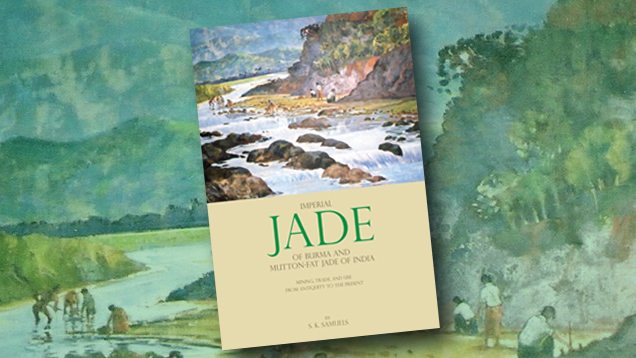Books: Imperial Jade of Burma and Mutton-Fat Jade of India

Imperial Jade of Burma and Mutton-Fat Jade of India was written by Burmese native (and longtime U.S. resident) S.K. Samuels. There is much within its pages that will both thrill and enlighten the reader. I was particularly impressed by the author's wonderful accounts of Chinese nephrite brought to India for working by the subcontinent’s expert lapidaries during the Mughal Empire (1526–1857).
One of Samuels’s stated goals was to clarify the importance of Myanmar to the history of jade, while clearing up well-established inconsistencies. As an example, he cites the account of a British consular officer stationed in China named Mr. Warry, who visited Burma in 1888 with the first expedition of British troops. Warry not only spoke Chinese, his 7000-word essay gave a detailed description of jade in China, including the nephrite deposits in Xinjiang. In this essay, Warry spends just 200 words relating a story told to him of the discovery of jade in Burma by a Chinese trader in the 13th century. Samuels dismisses this tale, but as evidence against it offers only vague statements by authors writing decades later, none of who had actually visited the Burmese jade mines. So whom does one believe, a China expert who visited the source and was presumably told of its discovery by someone at the site, or others who never visited the source? Samuels is free to disagree but he needs to build a better case than what is contained in this book.
In this text, Samuels repeatedly makes reference to the mistakes of other writers, but includes little in the way of quotations or citations to support his censure, and makes several unsubstantiated and inaccurate statements of his own. For instance, according to Samuels, by 2001, it was impossible for foreigners to visit either Mogok or Phakant; however, this reviewer visited both in 2004.
A full chapter is devoted to the gem material maw-sit-sit, but the name Eduard Gübelin does not appear at all. While this reviewer appreciates that maw-sit-sit had been mined for centuries and was mentioned by H.L. Chhibber in 1934, it was the Gübelin publications that put this material on the gemological map. Not to mention Gübelin’s impact is a significant omission in a book that claims to set the jade record straight.
Imperial Jade of Burma was privately published, but could have benefited greatly from a professional editor. Scholars (myself included) would welcome a comprehensive English-language volume on the history of Burmese jade, particularly one written by someone fluent in Burmese who could provide insights that only a native speaker might glean. Unfortunately, the current book falls short.
As an author myself, I appreciate the amount of work that goes into producing a book of this type. It is my sincere hope that the author will consider preparing a second, corrected edition. If done properly, it has the potential to become a valuable addition to the world gemological literature.



